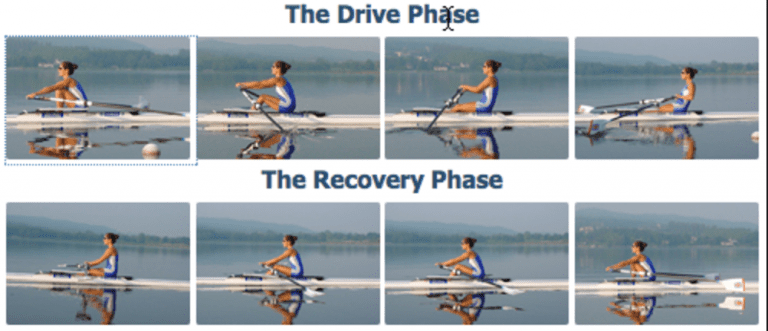Rowing drills and exercises aim to isolate each part of the ‘stroke cycle’ in order to assist coaches in successfully communicating the different stroke variation technique to athletes. By experiencing part of the ‘learning’ in the static environment of a rowing machine with a force curve to illustrate good execution before doing it in a boat, many athletes learn good technique faster.
Each drill has a core technique and a variant so you can adjust the exercise for advanced athletes.
Legs Only Rowing – Starting from the catch, make power phase only using legs, extract blade with straight arms and return to catch position. Shoulders remain swung forward and arms are straight throughout. Variant: legs only rowing with square blades.
Legs and Back only Rowing – As legs only, when legs are nearly straight the back is swung, then extract blade with straight arms and return to catch position. Arms remain straight throughout. Variant. 10 strokes legs only, 10 strokes legs and back; 10 strokes legs, back and arms (normal rowing).
Wide Grip Sculling – slide hands down handles until they are holding on below the rubber grips and on the narrow part of the blade shaft. Variant: Return hands to the lower part of the handle as an intermediate stage for 20 strokes before moving back to normal grip with hands on end of sculls and thumbs on end.
Inside Arm Rowing [equivalent to wide grip sculling above] -slide inside arm down the blade loom until it is double the normal width of the hand grip. Variant: Move inside arm further away down blade or place inside arm onto back-stay of rigger.
Quarter Slide Push – Starting from catch position blades are placed into the water and one quarter (6 inches) of the slide is covered just by pushing with the legs. When quarter slide is reached the blades arc extracted remaining squared and recovery to catch position. Variant: 10 strokes Quarter slide push. 10 strokes legs only rowing, 10 strokes legs and back only rowing, 10 strokes normal rowing.
– Building your Skills using Drills and other Education Book 
No handle rowing (on dynamic rowing machines — this does not work on Concept 2). Let the athlete move their legs to full compression catch position and then instruct them to ‘let the legs fall until they are straight’. The athlete can find a rhythm to this action identical to rowing rhythm. Then they can pick up the handle and continue with the legs moving in the same rhythm and just time the movements with their hands to the rhythm set by the legs. Note: Although this can be practiced in crew boats the rhythm achieved is not perfect because of the dead weight of the crew mates the athlete is carrying.
Sculling Left hand lead exaggeration – From finish position hold right hand against body while left hand and arm extends straight. Once it is straight the right hand can extend to join the left – then body swing and slide to catch position. Variant: 10 strokes exaggeration left hand lead. 10 strokes normal sculling.
Single strokes finishing with weight on the feet – The pause point is between backstops position and quarter slide – let the athlete identify’ when they can put pressure on the balls of their feet and to pause for 3 seconds at this point. Variant: Pause only one stroke in three.
Double quick hands – From finish position at extraction to arms away position the athlete moves her hands twice as fast as normal ‘double quick’. The rest of the recovery is executed at normal speed. Variant: make the double quick phase from fnish position to the point when the weight is on the feet.







This Post Has 5 Comments
I’m interested in rowing drills and have read this article with pleasure.
I know most of above mentioned drills
But I ‘m not familiar with folloing drills.
Could you advise teh purpose of these drills to me ?
-Wide grip sculling
-Double quick hands
Thanks for asking – the purpose of wide grip sculling is to increase the gearing (load) of the stroke so the athlete can learn how to use their body weight to ‘hang off the handle’. Because the load is heavy the stroke rate is slowed and they need to use more effort to push the oar through the water.
Double quick hands – the purpose of this is to make the finish and extraction more ‘automatic’ and accurate so the athlete really knows where each hand is moving towards. By making the movement twice as fast as usual it helps to improve hand speed and the first half of the recovery.
Please try each exercise yourself and contact us again if you have more questions.
Sorry Rebeca but the oar does not go through the water (except slippage) one levers the boat past the blade (class 2 lever)
John
I’m pretty sure at I know the purpose of the drills, but others may not.. It would be useful if that information was also provided.
Dermot – good point.
here are links to other articles that explain in more depth
https://rowperfect.co.uk/rowing-drills-exercises-rowperfect/
Thanks for pointing that out!
Rebecca